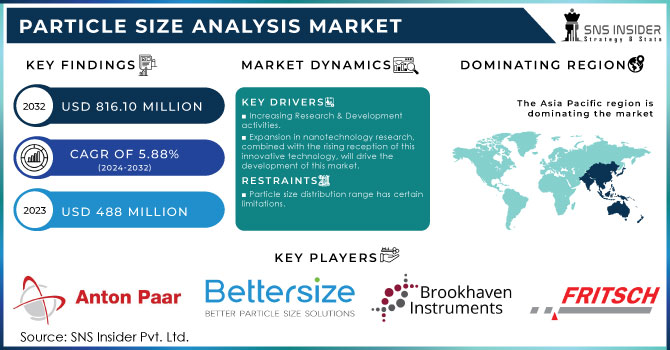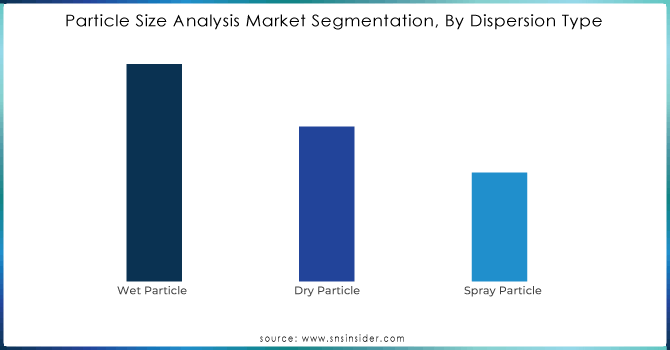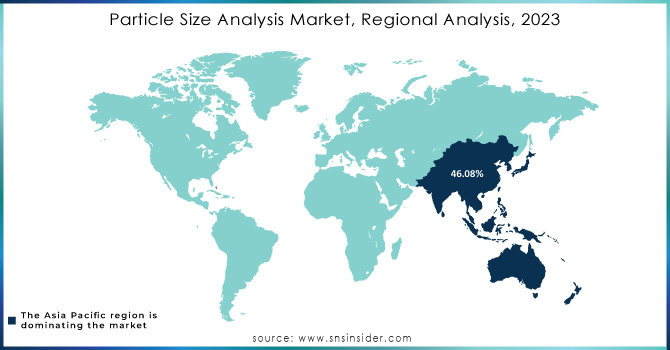Particle Size Analysis Market Report Scope & Overview:

To get more information on Particle Size Analysis Market - Request Free Sample Report
Particle Size Analysis Market size was valued at USD 488 million in 2023 and is expected to reach USD 816.10 million by 2032 with a growing CAGR of 5.88% over the forecast period of 2024-2032.
The Particle Size Analysis Market is witnessing substantial growth, driven by its expanding applications across industries such as pharmaceuticals, nanotechnology, chemicals, and construction. Particle size analysis is essential in determining the size distribution of particles in a sample, a factor that plays a critical role in quality control, research, and product development. Industries use this technique to ensure product consistency, safety, and efficacy, which is vital in sectors ranging from drug formulation to materials used in construction.
The growth of this market is largely attributed to the booming pharmaceutical and biotechnology industries. In drug formulation, particle size directly affects drug bioavailability, dissolution rates, and stability. As the demand for personalized medicine and complex drug delivery systems rises, precise particle size measurement becomes indispensable. The U.S., home to one of the largest pharmaceutical industries, is seeing increasing investments in research and development (R&D) for particle size analysis technologies. The U.S. pharmaceutical sector alone contributes over $1.2 trillion to the economy, and its growth directly impacts the demand for advanced particle size analysis tools. Technological advancements such as laser diffraction, dynamic light scattering (DLS), and nanoparticle tracking analysis (NTA) have revolutionized particle size measurement. These techniques provide higher accuracy and automation, making them indispensable for quality control and research labs in the U.S. The increasing focus on nanotechnology, particularly in drug delivery systems, semiconductors, and energy, has heightened demand for these tools, as nanoparticle size directly affects functionality and performance.
In the U.S., there is a growing trend toward automation and real-time monitoring systems in particle size analysis, enhancing process efficiency in industries like pharmaceuticals and chemicals. The push for sustainable manufacturing practices is also driving demand for precise particle analysis to minimize waste and optimize resource usage. Companies in the U.S. are focusing on R&D to develop portable, user-friendly instruments that offer enhanced accuracy and are environmentally friendly, ensuring compliance with stringent regulations while improving productivity.
MARKET DYNAMICS
DRIVERS
-
Rising demand for advanced pharmaceuticals and biologics is driving the need for precise particle size analysis to ensure drug formulation, bioavailability, and product efficacy in the pharmaceutical and biotechnology sectors.
The rising demand for advanced pharmaceuticals and biologics is fueling the need for precise particle size analysis in the pharmaceutical and biotechnology sectors. Particle size plays a crucial role in drug formulation as it affects the solubility, dissolution rate, and bioavailability of active ingredients, ultimately influencing the drug's efficacy and safety. In the case of biologics, which are complex molecules like proteins and monoclonal antibodies, maintaining a uniform particle size distribution is critical to ensuring stability and minimizing the risk of aggregation or immunogenic reactions.
Precise particle size analysis enables pharmaceutical companies to fine-tune formulations, ensuring that the body properly absorbs the drug's active ingredients. This is particularly important for controlled-release drugs and inhalable medications, where consistent particle size ensures predictable and effective delivery to the target area. Additionally, regulatory agencies such as the FDA have stringent requirements for the characterization of particle size to ensure quality control in drug production. The importance of accurate particle size analysis is growing as the pharmaceutical industry continues to innovate with complex formulations and novel delivery methods. This is driving investment in advanced analytical tools and technologies to meet the industry's evolving needs, supporting the development of more effective and safer treatments for patients.
-
Technological advancements in particle size analysis instruments, like laser diffraction and dynamic light scattering, are enhancing accuracy, speed, and usability, driving broader industry adoption and market growth.
Technological advancements in particle size analysis instruments, such as laser diffraction and dynamic light scattering, are significantly improving their accuracy, speed, and ease of use. These innovations allow for more precise particle size distribution measurements, which is crucial for industries like pharmaceuticals, chemicals, and materials science. Instruments equipped with these technologies provide faster results with enhanced reproducibility, reducing the time and effort required for analysis. Additionally, improved usability through user-friendly interfaces and automated features makes these devices more accessible to a wider range of industries. This increased efficiency and reliability are driving broader adoption, as industries seek high-performance tools for quality control and research applications. As a result, these advancements are contributing to the overall growth of the particle size analysis market.
RESTRAIN
-
The high initial cost of advanced particle size analysis equipment limits adoption, especially among smaller companies and research institutions, restraining market growth.
The high initial cost of advanced particle size analysis equipment poses a significant barrier to market adoption, particularly among smaller companies and research institutions with limited budgets. These advanced systems, while offering precise measurement and valuable insights, require substantial upfront investment for acquisition, installation, and maintenance. As a result, smaller organizations often face financial constraints, preventing them from adopting the latest technology. This cost factor restricts market growth, as the demand is skewed toward larger enterprises and well-funded research facilities. Additionally, alternative, lower-cost methods of particle size analysis may be preferred by smaller entities, further slowing the adoption of cutting-edge equipment. Without cost-effective solutions or financial incentives, the market faces a hurdle in expanding its reach to a broader customer base.
KEY MARKET SEGMENTATION
By Technology
The laser diffraction technology segment dominated the market share over 34.08% in 2023. Laser diffraction technology is renowned for its precision and accuracy when measuring particle size distributions. Industries that need accurate measurements rely on it for detailed and trustworthy information on particle sizes. Furthermore, meeting strict regulatory standards in diverse sectors requires accurate particle size measurement, highlighting the importance of laser diffraction.
By Dispersion Type
The wet particle dispersion type 2023 segment dominated the market share by over 35.03% in 2023. The method of wet particle dispersion is a useful technique employed in different industries to measure and examine the sizes of particles in liquid suspensions. Because wet dispersion methods provide a high level of precision and accuracy in measuring particle sizes, they are ideal for situations where precise size data is essential.

Need any customization research on Particle Size Analysis Market - Enquiry Now
By End-user
The healthcare end-use segment dominated the market share at over 22.06% in 2023Particle size analysis is employed in the development of medical devices like drug-eluting stents and implants to evaluate coatings, drug carriers, and materials for safety and effectiveness. Additionally, it is applied in creating diagnostic assays and tests like immunoassays, lateral flow tests, and point-of-care (PoC) diagnostics, where the size of particles can affect test performance.
REGIONAL ANALYSIS
Asia Pacific dominated the market share over 46.08% in 2023. The Asia Pacific market caters to various sectors such as pharmaceuticals, chemicals, materials science, food & beverages, environmental monitoring, and electronics. The increasing need for particle size analysis equipment in various industries is being fueled by the fast economic growth and industrialization in countries such as China and India. Furthermore, there is growth in the pharmaceutical sector in the Asia Pacific, particularly in drug development, resulting in a higher need for particle size analysis in the formulation and quality control.

KEY PLAYERS
Some of the major key players of Particle Size Analysis Market
-
Anton Paar GmbH: PSA Series (Particle Size Analyzer)
-
Bettersize Instruments Ltd..: Bettersizer S3 Plus (Laser Diffraction Particle Size Analyzer)
-
Brookhaven Instruments: NanoBrook Series (Dynamic Light Scattering Particle Size Analyzer)
-
Fritsch GmbH: ANALYSETTE 22 NeXT (Laser Particle Sizer)
-
Horiba: LA-960V2 (Laser Scattering Particle Size Distribution Analyzer)
-
LS Instruments: NanoLab 3D (Dynamic Light Scattering System)
-
Mettler Toledo: ParticleTrack with FBRM Technology (In-situ Particle Size Analyzer)
-
Micromeritics Instrument Corporation: Saturn DigiSizer II (High-Resolution Laser Particle Size Analyzer)
-
Microtrac Retsch GmbH: SYNC Particle Size and Shape Analyzer
-
Shimadzu Corporation: SALD-2300 (Laser Diffraction Particle Size Analyzer)
-
TSI Incorporated: AEROTRAK Particle Counters
-
Malvern Panalytical: Mastersizer 3000 (Laser Diffraction Particle Size Analyzer)
-
Beckman Coulter: Coulter LS 13 320 XR (Laser Diffraction Particle Size Analyzer)
-
Particle Metrix GmbH: ZetaView PMX 110 (Nanoparticle Tracking Analyzer)
-
Sympatec GmbH: HELOS/BR (Laser Diffraction Particle Size Analyzer)
-
CILAS: CILAS 1190 (Laser Particle Size Analyzer)
-
Agilent Technologies: 1260 Infinity II SFC (Supercritical Fluid Chromatography for Particle Size Analysis)
-
JEOL Ltd.: JEM Series (Electron Microscopes for Particle Size Analysis)
-
Horiba Scientific: SZ-100 Nanoparticle Analyzer
-
Entegris: AccuSizer 780 SIS (Single Particle Optical Sizing System)
RECENT DEVELOPMENT
In June 2024: Advantest Corporation unveiled the WEL2100, a cutting-edge addition to its nanoSCOUTER line. The new product is customized to measure particles, which includes lipid nanoparticles for drug delivery, viruses, and exosomes. It may swiftly and accurately measure each particle's quantity, particle size, and zeta potential, catering to pharmaceutical and biotechnology R&D demands.
In March 2024: Malvern Panalytical, a subsidiary of Spectris PLC located in Egham, Surrey, United Kingdom, unveiled the Mastersizer 3000+, a cutting-edge laser diffraction particle sizing instrument. The Mastersizer 3000+ utilizes integrated artificial intelligence (AI) and data-driven software solutions to offer assistance in method development, data quality feedback, instrument monitoring, and troubleshooting advice. This advanced system is designed to cater to the requirements of experienced laser diffraction particle size analysts and new users across industries, including mining, battery manufacturing, additive manufacturing, and pharmaceutical quality control.
In August 2023: Anton Paar GmbH introduced Litesizer DIA 500, the latest addition to the Particle Analysis & Surface Charge (PC) product line. This innovative instrument brings dynamic image analysis to your fingertips, allowing for precise measurement of particle size and shape within the range of 0.8 µm to 8,000 µm. With 1 µm equaling 0.001 millimeter.
In May 2023: The Verder Group has acquired France's Formulaction S.A. and will integrate it into Microtrac MRB, a prominent manufacturer of Particle Characterization Systems within the group's Scientific Division.
| Report Attributes | Details |
|---|---|
| Market Size in 2024 | US$ 488 Million |
| Market Size by 2032 | US$ 816.10 Million |
| CAGR | CAGR of 5.88% From 2024 to 2032 |
| Base Year | 2023 |
| Forecast Period | 2024-2032 |
| Historical Data | 2020- 2022 |
| Report Scope & Coverage | Market Size, Segments Analysis, Competitive Landscape, Regional Analysis, DROC & SWOT Analysis, Forecast Outlook |
| Key Segments | • By Technology (Laser Diffraction, Dynamic Light Scattering, Imaging, Nanoparticle Tracking Analysis (NTA), Others) • By Dispersion Type (Wet Particle, Dry Particle, Spray Particle) • By End-user (Healthcare, Chemicals, Food & Beverage, Mining, Cosmetics, Pharmaceuticals, Energy, Others) |
| Regional Analysis/Coverage | North America (US, Canada, Mexico), Europe (Eastern Europe [Poland, Romania, Hungary, Turkey, Rest of Eastern Europe] Western Europe] Germany, France, UK, Italy, Spain, Netherlands, Switzerland, Austria, Rest of Western Europe]), Asia Pacific (China, India, Japan, South Korea, Vietnam, Singapore, Australia, Rest of Asia Pacific), Middle East & Africa (Middle East [UAE, Egypt, Saudi Arabia, Qatar, Rest of Middle East], Africa [Nigeria, South Africa, Rest of Africa], Latin America (Brazil, Argentina, Colombia, Rest of Latin America) |
| Company Profiles | Anton Paar GmbH, Beckman Coulter, Inc., Bettersize Instruments Ltd., Brookhaven Instruments, Fritsch GmbH, Horiba, LS Instruments, Malvern Panalytical Ltd., Mettler Toledo, Micromeritics Instrument Corporation, Microtrac Retsch GmbH, Shimadzu Corporation, TSI, Malvern Panalytical, Beckman Coulter, Particle Metrix GmbH, Sympatec GmbH, CILAS, Agilent Technologies, JEOL Ltd, Horiba Scientific, Entegris and others |
| Key Drivers | • Rising demand for advanced pharmaceuticals and biologics is driving the need for precise particle size analysis to ensure drug formulation, bioavailability, and product efficacy in the pharmaceutical and biotechnology sectors. • Technological advancements in particle size analysis instruments, like laser diffraction and dynamic light scattering, are enhancing accuracy, speed, and usability, driving broader industry adoption and market growth. |
| Restraints | • The high initial cost of advanced particle size analysis equipment limits adoption, especially among smaller companies and research institutions, restraining market growth. |

